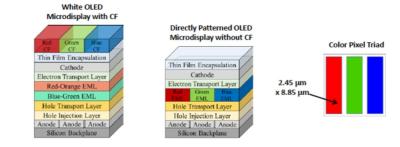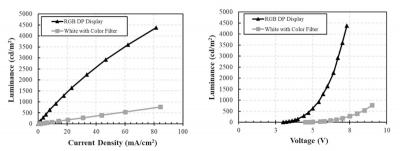In 2012, we first heard that eMagin is developing direct emission (or direct patterning, as the company calls it) OLED microdisplays. Fast forward into 2020, and the company is aiming to soon start producing such displays (it already launched its first such panel, see more below). In this article we'll look into the technology and the latest updates from eMagin.

All current OLED microdisplays on the market from all producers use a white OLED with color filter. This is a simple design, but it is wasteful in energy, as the filters block around 80% of the light, and in addition to achieve the white color one needs to use a blue OLED emitter (in addition to a yellow one, or red and green ones) - and blue is the least efficient color for OLED emission.

But this is about to change. The company recently received a large ($5.5 million) grant from the US Department of Defense to support its manufacturing base in the US, and a few days ago the DoD announced its full support grant for eMagin, which will be awarded with a further $33.6 million. This support will enable eMagin to acquire and install the equipment it requires to mass produce dPd microdisplays.
eMagin's traditional clients in the defense sector are highly interested in dPd technology, as it will enable higher brightness and higher efficiencies, which are of course critical for many defense related applications that require at-a-glance readability in mission critical applications.
But eMagin is looking beyond its traditional markets - and into the potentially much larger consumer AR market. The world's largest companies, including Apple, Facebook, Amazon, Google and Microsoft are all developing AR projects and are highly interested in microOLEDs.
eMagin has already signed development agreements with two of the world's top 5 companies in the AR/VR sector as reported in its SEC filings, and is probably working to design unique displays for these companies. It hopes to announce new partnerships soon with more AR companies, as its dPd displays represent the state-of-the-art for microdisplays, in terms of brightness and efficiency.
eMagin hopes that once the equipment is in place, it will have the capacity to produce over a million microdisplays in a year - this is a drastic increase in capacity indeed - but it will not be enough for consumer AR. The company will probably have to sign license agreements with third party fabs that will allow them to produce its AR OLED microdisplays at the large volumes required by the AR vendors.
eMagin is already offering its first dPd display, a 0.9-inch 1920x1200 display (2,600 PPI) that supports up to 7,500 cd/m2 of brightness. eMagin aims to increase the brightness to 10,000 cd/m2 by the end of Q3 2020.
This is going to be an exciting time for eMagin - and we look forward to hearing more about the company's dPd technology and its adventures in the AR space!
The author of this article holds some shares in eMagin, acquired privately

